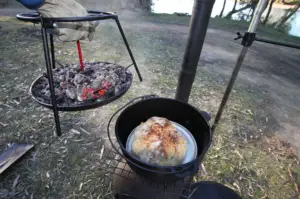FIRE IT UP!
Our experts help you to choose the perfect campfire cooking option
WORDS AND IMAGES BY GRANT HANAN & LINDA BLOFFWITCH
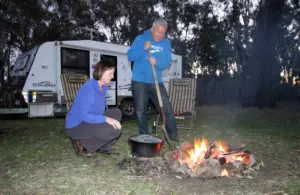
What can be more satisfying when you’re free camping than having a small comfort fire which doubles for cooking some delicious camp fare? But these days many places restrict when and where you can have a fire. Let’s look at some alternatives to the typical open fire and how the versatility of camp oven cooking can take your free camping experience to another level.
FIRE PITS EXPLAINED
If you’ve ever arrived at a campsite where signs state “fires are only allowed in designated fire pit areas”, what does this actually mean? Simply put, you would expect to find some form of man-made pit in a cleared area specifically for visitor use. This could consist of concrete rings and/ or a steel ring of some type. You could also find rocks heaped and placed in a circle. Given these types of fire pits can’t be moved, consider how you will position your set up if you want to use it for a fire. These types of fire pits are often put in place to prevent multiple fires scarring the landscape.
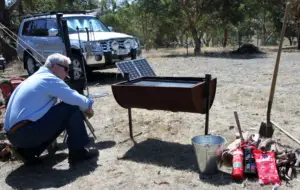
FIRE PIT TYPES
Fire pits today are either fixed or portable, and some are more effective than others. Let’s look at what’s on offer.
OPEN GROUND
The open ground fire pit provides a nice looking, ambient fire, but isn’t always efficient as the heat disperses. Controlling the fire for cooking can be difficult and this type of fire generally uses large amounts of wood.
BARREL TYPE
This type of fire pit is often a DIY project using old drums, kegs, old washing machine barrels, or steel rims. They contain the fire within the size of the drum and can be more efficient than the open ground fire pit. The downside is they can be bulky and awkward to store and transport with your RV. But they can be cheap to knock up which makes them a popular choice.
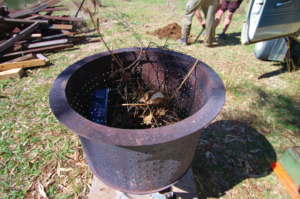
DEDICATED PROPRIETARY MADE FIRE PITS
There are many varieties and types available on the market and are best categorised as follows:
1. Type A – the brazier garden ornament style
2. Type B – the dedicated trough style
3. Type C – steel flat pack that needs to be assembled each time
4. Type D – designed and manufactured for cooking
These types of fire pits vary in price, practicality and weight. Some are easier to store than others whereas some require time to assemble or open out. A major advantage for many of these types is they have more than one purpose. If additional accessories are available, they can provide opportunities for cooking whilst still enjoying the ambience of a fire.
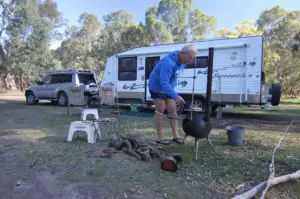
LEGALITIES
There is no blanket ruling for how campfires are treated in national parks. Some allow fires during the permitted season, some don’t. Many parks also insist you bring your own wood whereas others supply it. Some even have firewood collection point areas. With all the variables of having a national park campfire, research the park you’re considering to visit.
Take all the necessary precautions when setting up your fire pit and check for any restrictions before lighting. Wood source fires of any kind are not permitted during a fire ban period. Check your fire pit is entirely extinguished before departing, and remember to leave no trace.
CAMP OVENS
With your fire pit in full swing, there is nothing better than dining on a magnificent camp oven stew, homemade bread or damper when you’re out camping. Having a good quality camp oven as part of your cooking repertoire can see you whipping up delicious dishes like these with a little practice in no time. Spun steel or traditional cast iron are two popular types of camp oven cookware and both produce perfect results. It’s their maintenance and cooking techniques that vary.
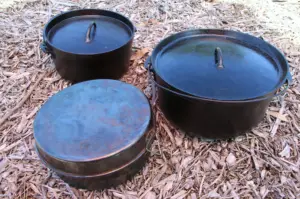
CAST IRON
Different forms of cast iron camp ovens have been around forever! They come in a variety of shapes and sizes, and are an excellent cooking source. Whether you’re roasting, baking, stewing or frying, the cast iron camp oven can accommodate the lot. There is no denying they are heavier than other camp oven alternatives, but many cast iron cooking die-hards will say you just can’t go past their good quality and reliability.
SPUN STEEL
This type of camp oven also comes in various shapes and sizes, and its manufacturing process sees it somewhat lighter than cast iron. The quality of the steel and the thickness of the camp oven walls play a big part when it comes to longevity and cooking quality. Being lighter than cast iron is a major advantage, although you need better control of your heat source because of heat transfer.
CAMP OVEN MAINTENANCE
If your camp oven has excess food burnt to the bottom, or is poorly seasoned will cause food to stick. Don’t be tempted to use harsh abrasives to scratch the camp oven’s surface if this occurs. Remove the residue by simply placing some water (don’t use soap) in the camp oven, return it to the heat for a while before wiping out. Put it back onto the heat to dry entirely. Give it a wipe over (inside and outside) with oil while still warm to prevent rusting. The camp oven will need to be reseasoned if the surface has been scratched. To prevent breakages, place the camp oven in a protective bag when travelling. Or even better, use a box for a cast iron camp oven as it can be easier to store.
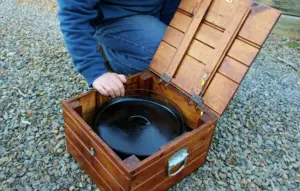
There are many lifestyle advantages of having a fire pit and topping it off with a delicious camp oven meal. Without a doubt, having a fire is a natural drawcard that brings people together, and camp oven cooking further enhances that experience. So when you’re thinking about your next free camping adventure, why not consider cooking some meals on a fire pit? We don’t think you’ll ever regret it!
